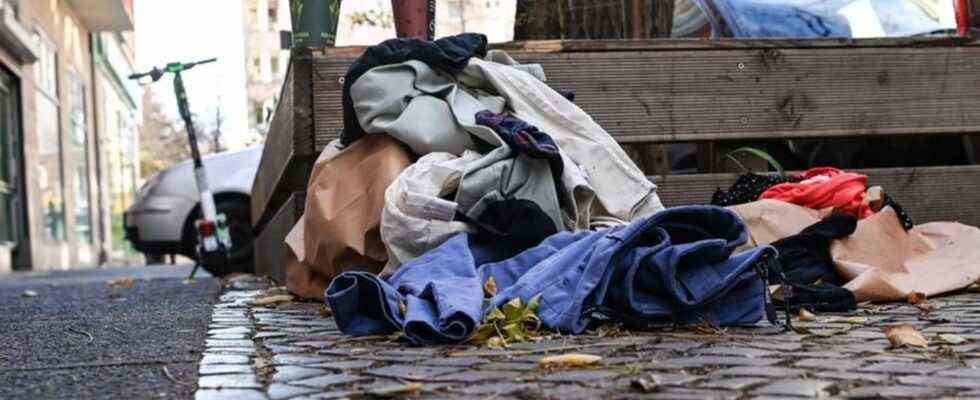New fashions from old clothes – that sounds tempting, because the textile industry pollutes the environment and the climate. But to do that is more difficult than expected.
Constantly new collections in the shops, cheap fashion for the price of a coffee that encourages buying, wearing and throwing away.
However, the environmental and climate impact of the textile industry is enormous, so something has to change. More and more fashion companies are advertising sustainable materials, but there is still no real cycle in which old clothes become new textiles.
The textile industry is one of the world’s largest branches of industry. The United Nations estimate their size at 2.4 trillion dollars a year (around two trillion euros), with more than 75 million employees worldwide. “The fashion industry is the second largest consumer of water in the world and is responsible for eight to ten percent of carbon emissions – more than all international flights and shipping combined,” said the United Nations at the start of a UN project for sustainable fashion in 2019.
It is estimated that 50 billion tons of textiles are produced every year. Three quarters of this is likely to end up in landfills. With fast fashion, i.e. many collections and low prices, production doubled between 2000 and 2014, according to the McKinsey management consultancy, and wearing time halved. Another study shows: statistically, every German throws away around 4.7 kilograms of textiles each year. Only 500 grams of it would be recycled.
The consortium wear2wear with six companies in the textile industry aims to manufacture textiles from 100 percent used textiles. This includes the company Sympatex from Unterföhring in Upper Bavaria, which produces a waterproof, windproof and breathable membrane for functional textiles. By 2030, she only wants to use raw materials from a circular textile cycle, and everything should be 100 percent recyclable again, as spokeswoman Verena Bierling says.
However, a test by wear2wear companies with a rain jacket showed that the devil is in the details. With 500 kilograms of old polyester jackets, 230 meters of fabric could be woven, but 70 percent new fibers had to be added for quality reasons, as wear2wear spokeswoman Annette Mark says. The new fibers came from PET bottles, i.e. plastic. But environmentalists find it problematic when material is withdrawn from a functioning cycle such as plastic bottles.
The Swiss Materials Testing and Research Institute (Empa) compared the environmental impact of the jacket with the proportion of old jackets with a jacket made entirely of PET bottle fibers. The old clothes jacket did better in eleven environmental risk categories, such as global warming, poisonous pollution for ecosystems and water scarcity. But: “The energy expenditure for cleaning, decolorizing and the like remains enormous,” says Mark. Work will continue on the processes. “You shouldn’t lie in your pocket: we’re still at the very beginning.”
And polyester is still simple. It gets a lot more complicated with blended fabrics. But this is what the majority of clothing worldwide consists of. Processes to easily break down fabrics into components such as polyester, polyamide and cotton are in their infancy. Only five percent of the rain jackets that were recycled were not made of polyester, for example the adhesive between the membrane and the lining, but that clogged the nozzles of the spinning machines after the granulate melted during further processing. In addition, the cycle is not endless: “We can manage a recycle cycle, but after that it becomes difficult with the quality,” says Mark. The polymer loses quality and the new yarn becomes uneven.
The British company Worn Again Technologies is working on the separation of blended fabrics. Investors include the fashion company H&M and the Swiss technology company Sulzer. Sulzer is building a plant that will convert polyester and cotton clothing into polyester pellets and cellulose pulp, which can be spun back into fibers. The plant should produce 1000 tons of new fibers per year. But that would be a drop in the ocean compared to the quantities H&M sells.
According to a company spokesman, the proportion of recycled materials at H&M in 2020 was around six percent, at least twice as much as in the previous year. By 2025 it should be 30 percent. Among other things, the company founded the Itsapark online shop, which also sells second-hand clothing. How much that makes up for total sales, the spokesman does not say.
Greenpeace considers such activities to be window dressing. It gives customers a clear conscience so that they can then continue shopping carefree, says Greenpeace consumer expert Viola Wohlgemuth. Textile consumption must fundamentally change. The companies would have to become textile service providers. “Borrowing, sharing, swapping, repairing – that must be the model of the future, and clothing made from such sustainable models must be found everywhere in everyday life and cheaper than buying something new,” she says. H&M is also keen that fashion is used, resold, reused and recycled for as long as possible, the spokesman asserts.
The European Union wants to publish a textile strategy this year. Manufacturers should be held accountable so that they produce more durable textiles that cause less environmental damage and are easier to recycle.

